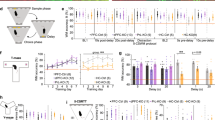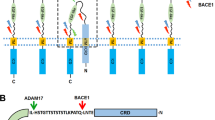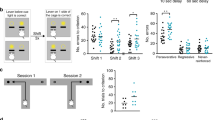Abstract
Calcyon regulates activity-dependent internalization of α-amino-3-hydroxyl-5-methyl-4-isoxazole-propionate (AMPA) glutamate receptors and long-term depression of excitatory synapses. Elevated levels of calcyon are consistently observed in brains from schizophrenic patients, and the calcyon gene is associated with attention-deficit hyperactivity disorder. Executive function deficits are common to both disorders, and at least for schizophrenia, the etiology appears to involve both heritable and neurodevelopmental factors. Here, we show with calcyon-overexpressing CalOE transgenic mice that lifelong calcyon upregulation impairs executive functions including response inhibition and working memory, without producing learning and memory deficits in general. As response inhibition and working memory, as well as the underlying neural circuitry, continue to mature into early adulthood, we functionally silenced the transgene during postnatal days 28–49, a period corresponding to adolescence. Remarkably, the response inhibition and working memory deficits including perseverative behavior were absent in adult CalOE mice with the transgene silenced in adolescence. Suppressing the calcyon transgene in adulthood only partially rescued the deficits, suggesting calcyon upregulation in adolescence irreversibly alters development of neural circuits supporting mature response inhibition and working memory. Brain regional immunoblots revealed a prominent downregulation of AMPA GluR1 subunits in hippocampus and GluR2/3 subunits in hippocampus and prefrontal cortex of the CalOE mice. Silencing the transgene in adolescence prevented the decrease in hippocampal GluR1, further implicating altered fronto-hippocampal connectivity in the executive function deficits observed in the CalOE mice. Treatments that mitigate the effects of high levels of calcyon during adolescence could preempt adult deficits in executive functions in individuals at risk for serious mental illness.
This is a preview of subscription content, access via your institution
Access options
Subscribe to this journal
Receive 12 print issues and online access
$259.00 per year
only $21.58 per issue
Buy this article
- Purchase on Springer Link
- Instant access to full article PDF
Prices may be subject to local taxes which are calculated during checkout









Similar content being viewed by others
References
Luna B, Padmanabhan A, O’Hearn K . What has fMRI told us about the development of cognitive control through adolescence? Brain Cogn 2010; 72: 101–113.
Green RJ, Stanton ME . Differential ontogeny of working memory and reference memory in the rat. Behav Neurosci 1989; 103: 98–105.
Davidson MC, Amso D, Anderson LC, Diamond A . Development of cognitive control and executive functions from 4 to 13 years: evidence from manipulations of memory, inhibition, and task switching. Neuropsychologia 2006; 44: 2037–2078.
Diamond A, Goldman-Rakic PS . Comparison of human infants and rhesus monkeys on Piaget's AB task: evidence for dependence on dorsolateral prefrontal cortex. Exp Brain Res 1989; 74: 24–40.
Diamond A . Developmental time course in human infants and infant monkeys, and the neural bases of, inhibitory control in reaching. Ann N Y Acad Sci 1990; 608: 637–669; discussion 669–676.
Hare T, Tottenham N, Galvan A, Voss H, Glover G, Casey B . Biological substrates of emotional reactivity and regulation in adolescence during an emotional go-nogo task. Biol Psychiatry 2008; 63: 927–934.
Huttenlocher P . Synaptic density in human frontal cortex—developmental changes and effects of aging. Brain Res 1979; 163: 195–205.
Bourgeois J, Goldman-Rakic P, Rakic P . Synaptogenesis in the prefrontal cortex of rhesus monkeys. Cereb Cortex 1994; 4: 78–96.
Woo T, Pucak M, Kye C, Matus C, Lewis D . Peripubertal refinement of the intrinsic and associational circuitry in monkey prefrontal cortex. Neuroscience 1997; 80: 1149–1158.
Paus T, Keshavan M, Giedd JN . Why do many psychiatric disorders emerge during adolescence? Nat Rev Neurosci 2008; 9: 947–957.
Williams N, Norton N, Williams H, Ekholm B, Hamshere M, Lindblom Y et al. A systematic genomewide linkage study in 353 sib pairs with schizophrenia. Am J Hum Genet 2003; 73: 1355–1367.
Holliday EG, McLean DE, Nyholt DR, Mowry BJ . Susceptibility locus on chromosome 1q23-25 for a schizophrenia subtype resembling deficit schizophrenia identified by latent class analysis. Arch Gen Psychiatry 2009; 66: 1058–1067.
Mowry BJ, Ewen KR, Nancarrow DJ, Lennon DP, Nertney DA, Jones HL et al. Second stage of a genome scan of schizophrenia: study of five positive regions in an expanded sample. Am J Med Genet 2000; 96: 864–869.
Fallin MD, Lasseter VK, Wolyniec PS, McGrath JA, Nestadt G, Valle D et al. Genomewide linkage scan for schizophrenia susceptibility loci among Ashkenazi Jewish families shows evidence of linkage on chromosome 10q22. Am J Hum Genet 2003; 73: 601–611.
Moon HJ, Yim S, Lee WK, Jeon Y, Kim YH, Ko YJ et al. Identification of DNA copy-number aberrations by array-comparative genomic hybridization in patients with schizophrenia. Biochem Biophys Res Commun 2006; 344: 531–539.
Ewald H, Flint T, Jorgensen T, Wang A, Jensen P, Vang M et al. Search for a shared segment on chromosome 10q26 in patients with bipolar affective disorder or schizophrenia from the Faroe Islands. Am J Med Genet 2002; 114: 196–204.
Venken T, Alaerts M, Souery D, Goossens D, Sluijs S, Navon R et al. Chromosome 10q harbors a susceptibility locus for bipolar disorder in Ashkenazi Jewish families. Mol Psychiatry 2008; 13: 442–450.
Davidson H, Xiao J, Dai R, Bergson C . Calcyon is necessary for activity-dependent AMPA receptor internalization and LTD in CA1 neurons of hippocampus. Eur J Neurosci 2009; 29: 42–54.
Tessier CR, Broadie K . Activity-dependent modulation of neural circuit synaptic connectivity. Front Mol Neurosci 2009; 2: 8.
Lynch GS, Dunwiddie T, Gribkoff V . Heterosynaptic depression: a postsynaptic correlate of long-term potentiation. Nature 1977; 266: 737–739.
Bastrikova N, Gardner G, Reece J, Jeromin A, Dudek S . Synapse elimination accompanies functional plasticity in hippocampal neurons. Proc Natl Acad Sci USA 2008; 105: 3123–3127.
Koh P, Bergson C, Undie A, Goldman-Rakic P, Lidow M . Up-regulation of the D1 dopamine receptor-interacting protein, calcyon, in patients with schizophrenia. Arch Gen Psychiatry 2003; 60: 311–319.
Bai J, He F, Novikova S, Undie A, Dracheva S, Haroutunian V et al. Abnormalities in the dopamine system in schizophrenia may lie in altered levels of dopamine receptor-interacting proteins. Biol Psychiatry 2004; 56: 427–440.
Clinton S, Ibrahim H, Frey K, Davis K, Haroutunian V, Meador-Woodruff J . Dopaminergic abnormalities in select thalamic nuclei in schizophrenia: involvement of the intracellular signal integrating proteins calcyon and spinophilin. Am J Psychiatry 2005; 162: 1859–1871.
Baracskay K, Haroutunian V, Meador-Woodruff J . Dopamine receptor signaling molecules are altered in elderly schizophrenic cortex. Synapse 2006; 60: 271–279.
Coyle JT . Glutamate and schizophrenia: beyond the dopamine hypothesis. Cell Mol Neurobiol 2006; 26: 365–384.
Sodhi M, Wood KH, Meador-Woodruff J . Role of glutamate in schizophrenia: integrating excitatory avenues of research. Expert Rev Neurother 2008; 8: 1389–1406.
Heijtz R, Kolb B, Forssberg H . Motor inhibitory role of dopamine D1 receptors: implications for ADHD. Physiol Behav 2007; 92: 155–160.
Dasbanerjee T, Middleton F, Berger D, Lombardo J, Sagvolden T, Faraone S . A comparison of molecular alterations in environmental and genetic rat models of ADHD: a pilot study. Am J Med Genet B Neuropsychiatr Genet 2008; 147B: 1554–1563.
Loo S, Fisher S, Francks C, Ogdie M, MacPhie I, Yang M et al. Genome-wide scan of reading ability in affected sibling pairs with attention-deficit/hyperactivity disorder: unique and shared genetic effects. Mol Psychiatry 2004; 9: 485–493.
Fisher S, Francks C, McCracken J, McGough J, Marlow A, MacPhie I et al. A genomewide scan for loci involved in attention-deficit/hyperactivity disorder. Am J Hum Genet 2002; 70: 1183–1196.
Quirk G, Mueller D . Neural mechanisms of extinction learning and retrieval. Neuropsychopharmacology 2008; 33: 56–72.
Spooner RI, Thomson A, Hall J, Morris RG, Salter SH . The Atlantis platform: a new design and further developments of Buresova's on-demand platform for the water maze. Learn Mem 1994; 1: 203–211.
Mayford M, Abel T, Kandel E . Transgenic approaches to cognition. Curr Opin Neurobiol 1995; 5: 141–148.
Zelenin S, Aperia A, Diaz HR . Calcyon in the rat brain: cloning of cDNA and expression of mRNA. J Comp Neurol 2002; 446: 37–45.
Oakman S, Meador-Woodruff J . Calcyon transcript expression in macaque brain. J Comp Neurol 2004; 468: 264–276.
Ramirez-Amaya V, Vazdarjanova A, Mikhael D, Rosi S, Worley P, Barnes C . Spatial exploration-induced Arc mRNA and protein expression: evidence for selective, network-specific reactivation. J Neurosci 2005; 25: 1761–1768.
Negyessy L, Bergson C, Garab S, Simon L, Goldman-Rakic P . Ultrastructural localization of calcyon in the primate cortico-basal ganglia-thalamocortical loop. Neurosci Lett 2008; 440: 59–62.
Trantham-Davidson H, Vazdarjanova A, Dai R, Terry A, Bergson C . Up-regulation of calcyon results in locomotor hyperactivity and reduced anxiety in mice. Behav Brain Res 2008; 189: 244–249.
Kim JH, Hamlin AS, Richardson R . Fear extinction across development: the involvement of the medial prefrontal cortex as assessed by temporary inactivation and immunohistochemistry. J Neurosci 2009; 29: 10802–10808.
Frankle WG, Lerma J, Laruelle M . The synaptic hypothesis of schizophrenia. Neuron 2003; 39: 205–216.
Chen J, Kelz M, Zeng G, Sakai N, Steffen C, Shockett P et al. Transgenic animals with inducible, targeted gene expression in brain. Mol Pharmacol 1998; 54: 495–503.
Lee S, Liu L, Wang Y, Sheng M . Clathrin adaptor AP2 and NSF interact with overlapping sites of GluR2 and play distinct roles in AMPA receptor trafficking and hippocampal LTD. Neuron 2002; 36: 661–674.
Spear LP . Adolescent Brain Development and Animal Models. Ann N Y Acad Sci 2004; 1021: 23–26.
Farinelli M, Deschaux O, Hugues S, Thevenet A, Garcia R . Hippocampal train stimulation modulates recall of fear extinction independently of prefrontal cortex synaptic plasticity and lesions. Learn Mem 2006; 13: 329–334.
Garcia R, Spennato G, Nilsson-Todd L, Moreau J, Deschaux O . Hippocampal low-frequency stimulation and chronic mild stress similarly disrupt fear extinction memory in rats. Neurobiol Learn Mem 2008; 89: 560–566.
Vazdarjanova A, McGaugh J . Basolateral amygdala is not critical for cognitive memory of contextual fear conditioning. Proc Natl Acad Sci USA 1998; 95: 15003–15007.
Izaki Y, Takita M, Akema T . Specific role of the posterior dorsal hippocampus-prefrontal cortex in short-term working memory. Eur J Neurosci 2008; 27: 3029–3034.
Lee I, Kesner RP . Time-dependent relationship between the dorsal hippocampus and the prefrontal cortex in spatial memory. J Neurosci 2003; 23: 1517–1523.
Jones MW, Wilson MA . Theta rhythms coordinate hippocampal-prefrontal interactions in a spatial memory task. PLoS Biol 2005; 3: e402.
Floresco SB, Seamans JK, Phillips AG . Selective roles for hippocampal, prefrontal cortical, and ventral striatal circuits in radial-arm maze tasks with or without a delay. J Neurosci 1997; 17: 1880–1890.
Siapas AG, Lubenov EV, Wilson MA . Prefrontal phase locking to hippocampal theta oscillations. Neuron 2005; 46: 141–151.
Paz R, Bauer EP, Paré D . Theta synchronizes the activity of medial prefrontal neurons during learning. Learn Mem 2008; 15: 524–531.
Duncan J, Owen A . Common regions of the human frontal lobe recruited by diverse cognitive demands. Trends Neurosci 2000; 23: 475–483.
Holt DJ, Lebron-Milad K, Milad MR, Rauch SL, Pitman RK, Orr SP et al. Extinction memory is impaired in schizophrenia. Biol Psychiatry 2009; 65: 455–463.
Clark L, Blackwell A, Aron A, Turner D, Dowson J, Robbins T et al. Association between response inhibition and working memory in adult ADHD: a link to right frontal cortex pathology? Biol Psychiatry 2007; 61: 1395–1401.
Petralia RS, Wenthold RJ . Light and electron immunocytochemical localization of AMPA-selective glutamate receptors in the rat brain. J Comp Neurol 1992; 318: 329–354.
Vickers JC, Huntley GW, Edwards AM, Moran T, Rogers SW, Heinemann SF et al. Quantitative localization of AMPA/kainate and kainate glutamate receptor subunit immunoreactivity in neurochemically identified subpopulations of neurons in the prefrontal cortex of the macaque monkey. J Neurosci 1993; 13: 2982–2992.
Martin LJ, Blackstone CD, Levey AI, Huganir RL, Price DL . AMPA glutamate receptor subunits are differentially distributed in rat brain. Neuroscience 1993; 53: 327–358.
Ye E, Kim T, Choi J, Jin M, Jeon Y, Kim M et al. Ionotropic glutamate receptor GluR1 in the visual cortex of hamster: distribution and co-localization with calcium-binding proteins and GABA. Acta Histochem Cytochem 2006; 39: 47–54.
Xiao J, Dai R, Negyessy L, Bergson C . Calcyon, a novel partner of clathrin light chain, stimulates clathrin-mediated endocytosis. J Biol Chem 2006; 281: 15182–15193.
Dalton G, Wang Y, Floresco S, Phillips A . Disruption of AMPA receptor endocytosis impairs the extinction, but not acquisition of learned fear. Neuropsychopharmacology 2008; 33: 2416–2426.
Matsuo N, Reijmers L, Mayford M . Spine-type-specific recruitment of newly synthesized AMPA receptors with learning. Science 2008; 319: 1104–1107.
Gourley SL, Kedves AT, Olausson P, Taylor JR . A history of corticosterone exposure regulates fear extinction and cortical NR2B, GluR2/3, and BDNF. Neuropsychopharmacology 2008; 34: 707–716.
Zushida K, Sakurai M, Wada K, Sekiguchi M . Facilitation of extinction learning for contextual fear memory by PEPA: a potentiator of AMPA receptors. J Neurosci 2007; 27: 158–166.
Bannerman DM, Deacon RMJ, Seeburg PH, Rawlins JNP . GluR-A-Deficient mice display normal acquisition of a hippocampus-dependent spatial reference memory task but are impaired during spatial reversal. Behav Neurosci 2003; 117: 866–870.
Zamanillo D, Sprengel R, Hvalby O, Jensen V, Burnashev N, Rozov A et al. Importance of AMPA receptors for hippocampal synaptic plasticity but not for spatial learning. Science 1999; 284: 1805–1811.
Reisel D, Bannerman DM, Schmitt WB, Deacon RMJ, Flint J, Borchardt T et al. Spatial memory dissociations in mice lacking GluR1. Nat Neurosci 2002; 5: 868–873.
Bannerman DM . Fractionating spatial memory with glutamate receptor subunit-knockout mice. Biochem Soc Trans 2009; 37: 1323–1327.
Schmitt WB, Sprengel R, Mack V, Draft RW, Seeburg PH, Deacon RMJ et al. Restoration of spatial working memory by genetic rescue of GluR-A-deficient mice. Nat Neurosci 2005; 8: 270–272.
Pellegrini-Giampietro D, Gorter J, Bennett M, Zukin R . The GluR2 (GluR-B) hypothesis: Ca(2+)-permeable AMPA receptors in neurological disorders. Trends Neurosci 1997; 20: 464–470.
Insel TR, Miller LP, Gelhard RE . The ontogeny of excitatory amino acid receptors in rat forebrain—I. N-methyl-D-aspartate and quisqualate receptors. Neuroscience 1990; 35: 31–43.
Swulius MT, Kubota Y, Forest A, Waxham MN . Structure and composition of the postsynaptic density during development. J Comp Neurol 2010; 518: 4243–4260.
Spear L . The adolescent brain and age-related behavioral manifestations. Neurosci Biobehav Rev 2000; 24: 417–463.
Freeman JH, Stanton ME . Fimbria-fornix transections disrupt the ontogeny of delayed alternation but not position discrimination in the rat. Behav Neurosci 1991; 105: 386–395.
Lipska B, Aultman J, Verma A, Weinberger D, Moghaddam B . Neonatal damage of the ventral hippocampus impairs working memory in the rat. Neuropsychopharmacology 2002; 27: 47–54.
Andersen S, Teicher M . Stress, sensitive periods and maturational events in adolescent depression. Trends Neurosci 2008; 31: 183–191.
Akers K, Nakazawa M, Romeo R, Connor J, McEwen B, Tang A . Early life modulators and predictors of adult synaptic plasticity. Eur J Neurosci 2006; 24: 547–554.
Vawter MP, Crook JM, Hyde TM, Kleinman JE, Weinberger DR, Becker KG et al. Microarray analysis of gene expression in the prefrontal cortex in schizophrenia: a preliminary study. Schizophr Res 2002; 58: 11–20.
Folley BS, Astur R, Jagannathan K, Calhoun VD, Pearlson GD . Anomalous neural circuit function in schizophrenia during a virtual Morris water task. Neuroimage 2010; 49: 3373–3384.
Boos HBM, Aleman A, Cahn W, Pol HH, Kahn RS . Brain volumes in relatives of patients with schizophrenia: a meta-analysis. Arch Gen Psychiatry 2007; 64: 297–304.
Sişmanlar SG, Anik Y, Coşkun A, Aǧaoǧlu B, Karakaya I, Yavuz CI . The volumetric differences of the fronto-temporal region in young offspring of schizophrenic patients. Eur Child Adolesc Psychiatry 2010; 19: 151–157.
Meyer-Lindenberg AS, Olsen RK, Kohn PD, Brown T, Egan MF, Weinberger DR et al. Regionally specific disturbance of dorsolateral prefrontal-hippocampal functional connectivity in schizophrenia. Arch Gen Psychiatry 2005; 62: 379–386.
Wolf RC, Vasic N, Sambataro F, Höse A, Frasch K, Schmid M et al. Temporally anticorrelated brain networks during working memory performance reveal aberrant prefrontal and hippocampal connectivity in patients with schizophrenia. Prog Neuropsychopharmacol Biol Psychiatry 2009; 33: 1464–1473.
Bhojraj TS, Diwadkar VA, Sweeney JA, Prasad KM, Eack SM, Montrose DM et al. Longitudinal alterations of executive function in non-psychotic adolescents at familial risk for schizophrenia. Prog Neuropsychopharmacol Biol Psychiatry 2010; 34: 469–474.
Keshavan MS, Kulkarni S, Bhojraj T, Francis A, Diwadkar V, Montrose DM et al. Premorbid cognitive deficits in young relatives of schizophrenia patients. Front Hum Neurosci 2010; 3: 62.
Keefe RSE, Sweeney JA, Gu H, Hamer RM, Perkins DO, McEvoy JP et al. Effects of olanzapine, quetiapine, and risperidone on neurocognitive function in early psychosis: a randomized, double-blind 52-week comparison. Am J Psychiatry 2007; 164: 1061–1071.
Lewis D . Atypical antipsychotic medications and the treatment of schizophrenia. Am J Psychiatry 2002; 159: 177–179.
Acknowledgements
We thank Dr Sang Lee, Medical College of Wisconsin for the GluR plasmids, Drs Lynn Selemon, David Blake, Philip Wang and Jay Hegde for their comments on the manuscript, Kyle Layman, Nita Vakil and Jonathan Bean for technical support, and Dr Lin Mei for use of the EthoVision XT software. This work was supported by DoD Concept Award PT0713 and MCG PSRP Grant (CB), and MCG start-up funds and NIH Grant 1R21MH083188 (AV).
Author contributions: NM performed protein interaction studies, KB performed and quantified immunohistochemical studies, AV performed and analyzed behavioral experiments, and CB performed immunoblots and wrote the manuscript. AV and CB co-conceived the study.
Author information
Authors and Affiliations
Corresponding authors
Ethics declarations
Competing interests
The authors declare no conflict of interest.
Additional information
Supplementary Information accompanies the paper on the Molecular Psychiatry website
Supplementary information
Rights and permissions
About this article
Cite this article
Vazdarjanova, A., Bunting, K., Muthusamy, N. et al. Calcyon upregulation in adolescence impairs response inhibition and working memory in adulthood. Mol Psychiatry 16, 672–684 (2011). https://doi.org/10.1038/mp.2011.14
Received:
Revised:
Accepted:
Published:
Issue Date:
DOI: https://doi.org/10.1038/mp.2011.14
Keywords
This article is cited by
-
Hypervulnerability of the adolescent prefrontal cortex to nutritional stress via reelin deficiency
Molecular Psychiatry (2017)
-
Calcyon stimulates neuregulin 1 maturation and signaling
Molecular Psychiatry (2015)
-
A role for synaptic plasticity in the adolescent development of executive function
Translational Psychiatry (2013)
-
Chronic Adolescent Exposure to Delta-9-Tetrahydrocannabinol in COMT Mutant Mice: Impact on Indices of Dopaminergic, Endocannabinoid and GABAergic Pathways
Neuropsychopharmacology (2012)



